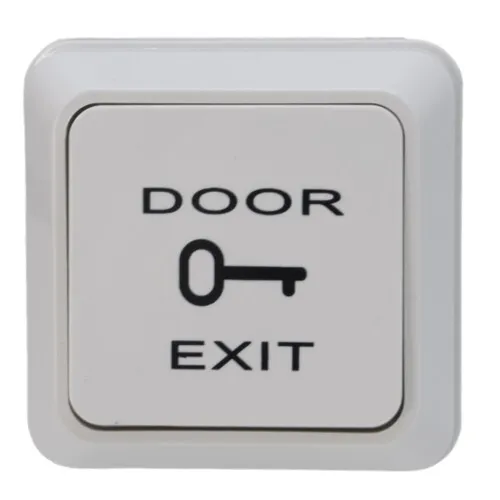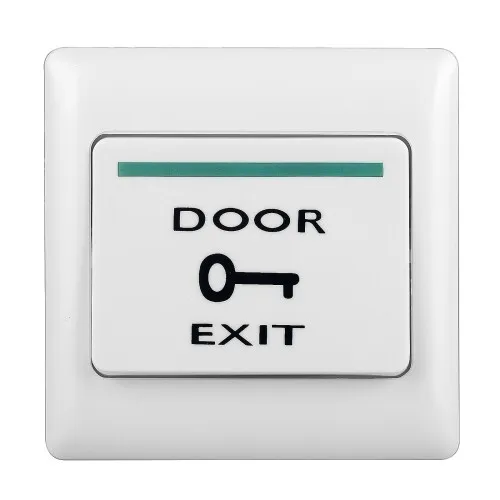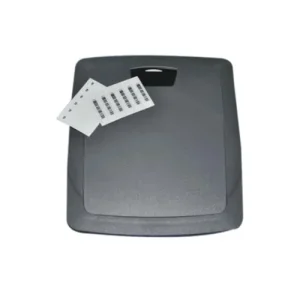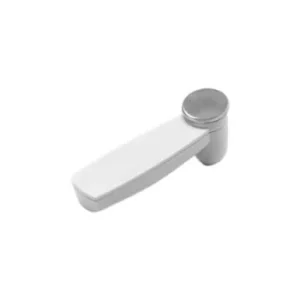Description
Businesses often implement security. This stops unauthorized building access. Access control systems handle this. They are on doors, exits, and gates. Only authorized people enter. Meanwhile, someone inside needs to exit. Exiting needs no complex equipment. A simple device unlocks the door. The push to exit button is a common choice.
What is a Push to Exit Button?
Push to exit buttons are vital. They are essential in access control. It is a spring-loaded button. Often, it mounts on a steel plate. The button styles vary. It can be simple or large. Some are green or illuminate with LEDs. The exit button serves as a “request to exit” device. It works on doors, exits, gates, and automation.
When to Install a Push to Exit Button
Versatility is a key advantage. Exit buttons suit electronic locks. They provide a free exit option. Use them on fire doors or gates. Install them anywhere with access control. They function as exit devices. They are used in residential, commercial, and industrial buildings.
Sometimes, they act as a backup. They open doors if the control panel fails. They are useful if a handle isn’t suitable. Or if a user cannot use the handle. The button must hold enough power. This allows the door to open freely.
How the Exit Push Button Works
The button connects to the access control system. Wires control the door’s locking mechanism. Anyone needing to exit simply pushes it.
When pressed, it momentarily releases the lock. It works for fail-secure or fail-safe locks. The exit button sends power to the magnetic lock. The door then automatically releases. This allows free exit. The lock disengages as required.
Types of Push to Exit Buttons
Mainly, there are two types. Regular wall-mount buttons are common. Motion sensors also trigger door unlocks. Panic exit devices like push bars exist too.
Either a push-to-exit or motion sensor works. They secure doors without standard locks. These are locks that are permanently engaged. You exit by triggering the sensor or button. A big manufacturer is ZKTeco.
Push to Exit Button Details
You see these buttons in many offices. They are often illuminated for emergencies. Push to exit buttons get heavy use. Investing in a good model pays off. Avoid “touch buttons” for exiting. You need quick, reliable operation. Frustration mounts if people can’t exit fast.
Modern Office Access
A door setup uses a push to exit button.
Note: A REX (Request to Exit) button is for standalone use. It primarily works on Fail-Safe locks. Fail-Secure locks generally allow free egress.
REX Button Installation Questions
First, consider your power source. Options include external power supply. Pro Controller’s power outputs are another choice.
Always use an external power supply. It provides needed amperage for components. Pulling over 4A through the Controller can short it. If no external supply, use Controller outputs. This works for small ancillary components.
Second, consider connecting your REX button. A typical REX button has five wires. These are +, -, COM, NO, NC. Only four are needed normally. Two wires (+, -) power the LED. Two wires (C-NC or C-NO) are signal wires. They connect to other components.
Wiring Guide Note: + and – might be LED+ and LED-. They function the same.
If unfamiliar, connect one pair at a time. The easiest order is as follows:
- Power the LED. Connect + and – on the REX button. Use a 12/24V power supply. The LED should light up. If not, check polarity. Swap wires and retest.
- Connect signal wires. Use Common (COM) and Normally Closed (NC). For Fail-Safe locks, maintain a closed circuit. This continuously powers the lock. Connect COM on REX to power supply positive. Connect NC on REX to the next component’s COM. This could be a motion sensor or maglock. Test this connection with power.
- Power the REX button itself. This is separate from the LED. Connect the REX button’s negative terminal. Attach it to the power supply’s negative lead. Connect the REX button’s positive terminal. Attach it to the power supply’s positive lead.When plugged in, the LED should light. If the circuit is complete, pressing it opens the circuit. This releases the door lock.
Troubleshooting
If the button doesn’t release the door, check the circuit. A failure is preventing power interruption. This could be a shorted wire. Or another failed device.
Test each option to open the circuit. Common options are keypad, push button, motion sensor. If other components work, narrow the issue.
Assume the REX button has the issue. Double-check all connections. Observe polarity in power connections. Ensure signal wires connect properly. Use NC and COM terminals. If problems persist, the REX button may be damaged. Consider installing a new one.
Choosing the Right Push to Exit Button
Choose the ideal exit button. It must suit your access control system. The right button depends on your door locking system. Available exit buttons include:
- N/C circuits: Normally Closed Circuit. This interrupts power when pressed.
- N/O circuits: Normally Open Circuit. This allows power flow when pressed.
- COM option: This works for both circuits.
Ensure compatibility with your system.
This product falls under Access Control and Security Systems.
Our Facebook Page





















Reviews
There are no reviews yet.